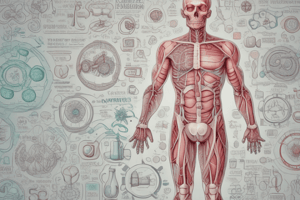Podcast
Questions and Answers
What is the main form of carbohydrates that is absorbed in the gastrointestinal tract (GIT)?
What is the main form of carbohydrates that is absorbed in the gastrointestinal tract (GIT)?
- Polysaccharides
- Disaccharides
- Monosaccharides (correct)
- Maltose
What is the pH range required for the activation of salivary amylase in the mouth?
What is the pH range required for the activation of salivary amylase in the mouth?
- 8.0 to 8.2
- 6.6 to 6.8 (correct)
- 5.5 to 5.8
- 7.0 to 7.2
Which enzyme converts polysaccharides to disaccharides in the gastrointestinal tract?
Which enzyme converts polysaccharides to disaccharides in the gastrointestinal tract?
- Sucrase-Isomaltase
- Maltase
- Pancreatic amylase
- Salivary amylase (correct)
Which enzyme is responsible for the hydrolysis of sucrose to fructose and glucose in the stomach?
Which enzyme is responsible for the hydrolysis of sucrose to fructose and glucose in the stomach?
What stops the enzyme action of salivary amylase in the stomach?
What stops the enzyme action of salivary amylase in the stomach?
Study Notes
Carbohydrate Absorption in the Gastrointestinal Tract (GIT)
- The main form of carbohydrates that is absorbed in the GIT is monosaccharides.
Enzyme Activation and Function
- Salivary amylase is activated in a pH range of 6.7-7.7.
- Salivary amylase converts polysaccharides to disaccharides in the mouth.
- Another enzyme, pancreatic amylase, continues to break down polysaccharides to disaccharides in the small intestine.
- Sucrase, an enzyme in the small intestine, is responsible for the hydrolysis of sucrose to fructose and glucose.
- Gastric acid, which has a low pH, stops the enzyme action of salivary amylase in the stomach.
Studying That Suits You
Use AI to generate personalized quizzes and flashcards to suit your learning preferences.
Description
Test your knowledge of amino acid metabolism with this quiz covering the degradation (catabolism) of amino acids, urea cycle, ammonia oxidation, and nitrogen balance. Explore topics such as negative and positive nitrogen balance, as well as the effects of different conditions on amino acid metabolism.




